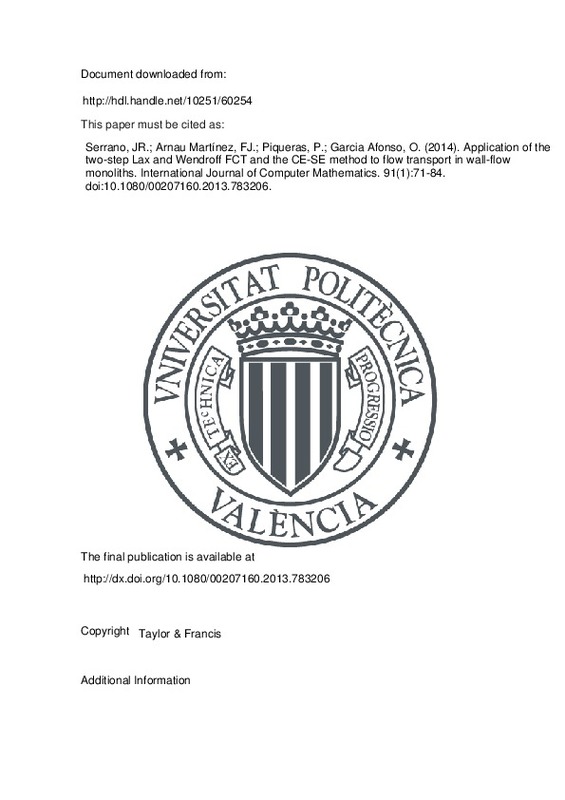JavaScript is disabled for your browser. Some features of this site may not work without it.
Buscar en RiuNet
Listar
Mi cuenta
Estadísticas
Ayuda RiuNet
Admin. UPV
Application of the two-step Lax and Wendroff FCT and the CE-SE method to flow transport in wall-flow monoliths
Mostrar el registro sencillo del ítem
Ficheros en el ítem
| dc.contributor.author | Serrano, J. R.
|
es_ES |
| dc.contributor.author | Arnau Martínez, Francisco José
|
es_ES |
| dc.contributor.author | Piqueras, P.
|
es_ES |
| dc.contributor.author | García Afonso, Óscar
|
es_ES |
| dc.date.accessioned | 2016-01-27T10:53:08Z | |
| dc.date.available | 2016-01-27T10:53:08Z | |
| dc.date.issued | 2014-01-02 | |
| dc.identifier.issn | 0020-7160 | |
| dc.identifier.uri | http://hdl.handle.net/10251/60254 | |
| dc.description.abstract | [EN] Gas dynamic codes are computational tools applied to the analysis of air management in internal combustion engines. The governing equations in one-dimensional elements are approached assuming compressible unsteady non-homentropic flow and are commonly solved applying finite difference numerical methods. These techniques can also be applied to the calculation of flow transport in complex systems such as wallflow monoliths. These elements are characterized by alternatively plugged channels with porous walls. It filters the particulates when the flowgoes through thewall from the inlet to the outlet channels. Therefore, this process couples the solution of every pair of inlet and outlet channels. In this study, the adaptation of the two-step Lax and Wendroff method and the space-time Conservation Element and Solution Element method is performed to be applied in the solution of flow transport in wall-flow monolith channels. The influence on the prediction ability is analysed by a shock-tube test and experimental data obtained under impulsive flow conditions. | es_ES |
| dc.description.sponsorship | This work has been partially supported by the Spanish Ministerio de Ciencia e Innovacion through grant number DPI2010-20891-C02-02. | |
| dc.language | Inglés | es_ES |
| dc.publisher | Taylor & Francis | es_ES |
| dc.relation.ispartof | International Journal of Computer Mathematics | es_ES |
| dc.rights | Reserva de todos los derechos | es_ES |
| dc.subject | diesel particulate filter | es_ES |
| dc.subject | Shock-capturing methods | es_ES |
| dc.subject | Lax and Wendroff | es_ES |
| dc.subject | CE-SE | es_ES |
| dc.subject | FCT | es_ES |
| dc.subject.classification | INGENIERIA AEROESPACIAL | es_ES |
| dc.subject.classification | MAQUINAS Y MOTORES TERMICOS | es_ES |
| dc.title | Application of the two-step Lax and Wendroff FCT and the CE-SE method to flow transport in wall-flow monoliths | es_ES |
| dc.type | Artículo | es_ES |
| dc.identifier.doi | 10.1080/00207160.2013.783206 | |
| dc.relation.projectID | info:eu-repo/grantAgreement/MICINN//DPI2010-20891-C02-02/ES/ELABORACION DE MODELOS TERMOFLUIDODINAMICOS Y TECNICAS EXPERIMENTALES PARA DESARROLLAR UN COLECTOR DE ESCAPE MULTIFUNCIONAL CON UN FILTRO DE PARTICULAS DIESEL INTEGRADO/ | es_ES |
| dc.rights.accessRights | Abierto | es_ES |
| dc.contributor.affiliation | Universitat Politècnica de València. Departamento de Máquinas y Motores Térmicos - Departament de Màquines i Motors Tèrmics | es_ES |
| dc.contributor.affiliation | Universitat Politècnica de València. Instituto Universitario CMT-Motores Térmicos - Institut Universitari CMT-Motors Tèrmics | es_ES |
| dc.description.bibliographicCitation | Serrano, JR.; Arnau Martínez, FJ.; Piqueras, P.; García Afonso, Ó. (2014). Application of the two-step Lax and Wendroff FCT and the CE-SE method to flow transport in wall-flow monoliths. International Journal of Computer Mathematics. 91(1):71-84. https://doi.org/10.1080/00207160.2013.783206 | es_ES |
| dc.description.accrualMethod | S | es_ES |
| dc.relation.publisherversion | http://dx.doi.org/10.1080/00207160.2013.783206 | es_ES |
| dc.description.upvformatpinicio | 71 | es_ES |
| dc.description.upvformatpfin | 84 | es_ES |
| dc.type.version | info:eu-repo/semantics/publishedVersion | es_ES |
| dc.description.volume | 91 | es_ES |
| dc.description.issue | 1 | es_ES |
| dc.relation.senia | 265521 | es_ES |
| dc.contributor.funder | Ministerio de Ciencia e Innovación |







![[Cerrado]](/themes/UPV/images/candado.png)

